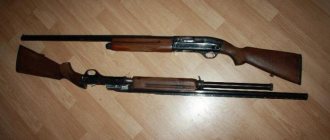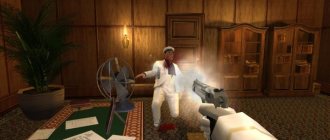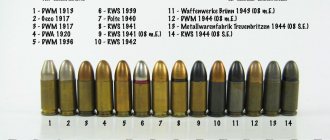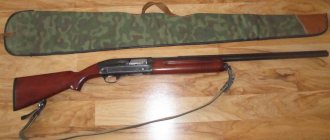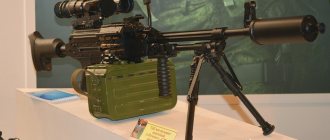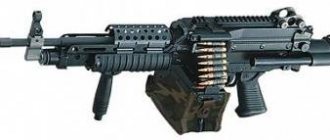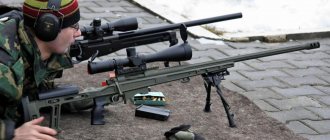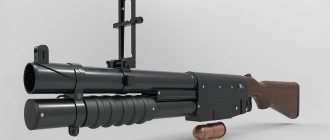About the product
A shortened version was developed for special forces to conduct operations in confined spaces. The standard layout of the Pecheneg PKP is not suitable for this. The bullpup version is included in the "Warrior" kit as part of the "Soldier of the Future" program.
The idea of creation belongs to the Vympel officer of the Special Purpose Center of the FSB of Russia. It differs from its predecessor in length and appearance. In addition, the new machine gun is not distinguished by its high-precision shooting at a long distance, but at 100–150 meters it easily hits the target. For the 7.62 x 54 cartridge, body armor is not a hindrance.
Application on the battlefield and the prospects of weapons.
After the new machine gun was put into service, the troops began to be saturated with new weapons. The first samples entered combat during the counter-terrorism operation in the North Caucasus.
During army combat tests, minor amendments and changes were made to the design, which came into force during the war in North Ossetia. Of course, it was impossible to replace an old PC, so for most, Pecheneg was clearly new.
Since the events of 2014, when the intervention of the Russian military in international affairs was required, work has been found for Pecheneg. Events in Crimea and Syria demonstrated these weapons to the whole world. In the first case there was no shooting. In the second, PKP showed itself in all its glory.
Despite the secrecy of most operations, the effectiveness of the Pechenegs is not in doubt.
PKPs are also in service with the Syrian army, so the information is given from more than one source.
In addition to the Syrians, the machine gun is used by the armed forces of Kazakhstan, Kyrgyzstan and Namibia. It is found as trophies among armed formations that enter into confrontation with the armies of the listed countries.
Designers do not stop working on modernizing the machine. The example with the bullpup variant indicates the enormous potential of the weapon. Combat use in numerous hot spots also provides food for thought. Each battle reveals one or another plus or minus of the weapon, which is taken into account by the designers.
pros
A new model of the Pecheneg assault machine gun with a bullpup was demonstrated to the president by the Kalashnikov concern on September 18, 2013 during his visit to Izhevsk.
Obvious advantages:
- The presence of a Picatinny rail, which provides for mounting an additional body kit.
- Instead of a flame arrester, the design includes a muzzle brake-compensator, which reduces the recoil of the machine gun.
- Small size compared to its predecessor (one of the priorities when modifying the Pecheneg to a bullpup).
- Weight has been reduced.
- Securely fixed bipods do not move during firing.
- The body and moving parts are made of high-strength alloy that is resistant to damage, corrosion and climate change.
- Serial production of “Pecheneg” with a bullpup costs less than the production of the original.
Description of the Pecheneg machine gun
The design is based on a 7.62 mm Kalashnikov machine gun. This made it possible to launch production in 1999 at minimal cost, as well as simplify its operation. The barrel group ensures the shooting of at least 600 rounds in long bursts without compromising shooting efficiency. When conducting a long battle, the machine gun can fire up to 10,000 rounds per hour without deteriorating combat characteristics or reducing barrel life. In general, Pecheneg retained up to 80% of the common parts with the PKM (receiver with all mechanisms, machine tool).
The Pecheneg can use the entire range of 7.62x54 mm R rifle cartridges. The machine gun uses a system of forced air cooling of the barrel using the energy of powder gases. The adjustable gas outlet mechanism allows the Pecheneg to be operated in any climatic conditions. The barrel has external fins and is enclosed in a metal casing. Powder gases leaving the barrel create a vacuum zone in the front part of the casing. In the rear part of the casing there are special ventilation windows. Thus, during shooting, cold air is continuously pumped along the barrel. Constantly cooling the barrel reduces dispersion when shooting and also increases the longevity of the barrel. The barrel life is 25-30 thousand shots when firing in intensive modes.
Strengthening the barrel made it possible to move the bipod from the gas chamber to the muzzle, which increased the support base and reduced dispersion to 70%, however, this position of the bipod is not always convenient, as it limits the sector of fire along the front without moving the shooter and/or weapon. Leveling the temperature field of the barrel made it possible to increase its resource to the level specified for the entire machine gun (or twice as compared to the PKM), as well as to reduce the drift of the aiming point during prolonged shooting to a value equal to no more than 0.001 of the range. This made it possible to abandon the second barrel (although the Pecheneg’s barrel mount remains quick-release) and, despite the installation of an additional screen on the machine gun, to reduce the carrying weight of the weapon. In addition, the design of the Pecheneg machine gun can significantly reduce the harmful effect of the upward flow of air heated by the barrel on the aiming line. The increased heat transfer of the new machine gun is noticeable in the dark even with the naked eye by the brightness of the barrels after the entire ammunition load has been fired.
Minuses
A number of undeniable advantages take the operation of the machine gun to a new level: the shortened version allows you to fire from both the left and right shoulder. However, there are disadvantages identified during operation:
- The presence of Picatinny rails makes it difficult to replace sights.
- The fuse is located in the same place, which causes inconvenience when switching.
- After installing a laser designator (LTC) or flashlight, it is difficult to get to the gas tube.
- The box with cartridges is located at an angle, which leads to bending of the machine gun belt and periodic problems when feeding cartridges into the chamber.
- To clean the forend, you will have to completely remove it, which is not always convenient under the conditions of the task.
- Inconvenient belt placement.
- Poor accuracy of fire at long distances (not in urban environments).
Add a comment Cancel reply
You must be logged in to post a comment.
“KALASHNIKOV” No. 4-5/2020
About Us
Subscription
Contacts
About Us
Magazine “KALASHNIKOV. Weapons, ammunition, equipment"
Founder of Azimut LLC. Certificate of registration of mass media PI No. 77-1343 dated December 10, 1999, issued by the Ministry of the Russian Federation for Press, Television and Radio Broadcasting and Mass Communications.
Editor-in-Chief Mikhail DEGTYAREV
Deputy Editor-in-Chief Sergei MOROZOV
Scientific editor Yuri PONOMAREV
Editor of the hunting and sports department Rimantas NOREIKA
Editor of the department of air weapons Vladimir LOPATIN
Advertising Director Vera PAKHOMOVA
Special correspondents Ruslan CHUMAK, Evgeny ALEXANDROV, Sergey MISHENEV
Site administrator Alexey DEGTYAREV
Design, layout Lyudmila MATVEEVA
Accountant Olga YASKEVICH
Distribution by Info Market Service LLC
General Director Marat MUSIN
Sales Director Tatyana KALICHKINA
The KALASHNIKOV magazine has been published since November 1999 and is the official printed publication of the Russian Practical Shooting Federation, the Union of Russian Gunsmiths and the All-Around Shooting Sports Federation. From 1997 to 1999 The magazine was published under the name “Gun. Weapons and ammunition."
In addition to the actual weapons of all types and times, KALASHNIKOV’s sphere of interests includes its practical use in any form: hunting, sports, combat use, recreational shooting, self-defense, etc.
KALASHNIKOV works closely with the leading European specialized publication - the German weapons magazine Deutsches Waffen-Journal (DWJ). The Russian-language version of the DWJ magazine, consisting of the most interesting articles for the domestic reader, is published monthly as part of KALASHNIKOV (in the “magazine within a magazine” format).
KALASHNIKOV magazine is a participant in the largest weapons exhibitions (SHOT Show, IWA, IDEX, Arms & Hunting, etc.) and at the invitation of the world's leading manufacturers of weapons and optics (Swarovski, Browning Winchester, Fabarm, Kahles, Sako, Blaser, Zoli, Zeiss , Merkel, Sheiring, Ceska Zbrojovka, Benelli) visits production complexes in various countries around the world.
The editorial team's close connection with all leading Russian importers of hunting weapons, domestic and foreign weapons factories and testing grounds ensures the reliability and professionalism of published materials about weapons, ammunition, equipment, history, hunting, shooting sports, and combat experience.
Among the authors of the KALASHNIKOV magazine are leading developers, testers, athletes, and experts, whose high reputation is known not only in Russia, but also abroad.
Certificate of registration of mass media PI No. 77-1343 dated December 10, 1999, issued by the Ministry of Press, Television and Radio Broadcasting and Mass Communications.
The magazine is published monthly, with a circulation of 30,000 copies.
We are pleased to welcome KALASHNIKOV readers to the updated website and hope that the new format will make it possible to use our entire information array with greater convenience and even influence the content of the magazine.
The main news is that in 2016 an electronic version of the magazine will be launched (without DWJ for now) on the website www.kalashnikov.ru. Articles from the magazine will appear on the website as they are converted into screen format, along with news from the latest issue. Registered visitors will have the opportunity to comment on articles.
The contents of the latest issue are available by clicking on its cover on the main page, and you can see individual articles to the right of it (available via the “Read more” link). Articles already published in electronic form are visible in the table of contents via active links. Fresh issues and subscription to the full format (with DWJ) in our branded applications in the App Store and Google Play remain paid (see the “Subscription” section), but as they become obsolete (a month after release), access to the issues becomes free.
TTX
The tactical and technical characteristics of the “Pecheneg” with a bullpup differ from the original. The product has the following characteristics:
- caliber of ammunition used - 7.62 x 54 mm;
- weight - 7.7 kg;
- total length - 915 mm, of which 650 are allocated to the barrel;
- maximum rate of fire - 650 rounds per minute;
- the bullet flies out with an initial speed of about 825 m/s;
- The machine gun is powered by a belt for 100 and 200 rounds;
- lethal range - up to 3.8 km;
- sighting - 1.5 km.
Pecheneg-SP machine gun
Pecheneg-SP (GRAU index - 6P69) - modernization of external devices of the Pecheneg machine gun and replacement of the barrel with a finned one without a casing with forced cooling. They include a low-noise firing device (tactical silencer), a front handle on the gas outlet, and a quick-release bipod. The cartridge box is lined with plastic inside. Picatinny rail on the receiver cover for mounting a unified optical sight 1P89-3. Adjustable in length, folding stock. The aiming bar of the mechanical sight is marked up to 800 meters.
Layout principle
Design bureaus from different countries have come to a new weapon layout in connection with the realities of modern military conflicts, characterized by combat operations in urban environments or in confined spaces.
The idea is to reverse the firing mechanism and the trigger. As a result, the first one moves towards the shooter’s shoulder, and the second one is carried forward. This configuration is used for assault and sniper rifles, shotguns and submachine guns. “Pecheneg with bullpup” is the first model of a machine gun made in a new layout.
The obvious advantages are its compactness. The primary goal of the design experiment was precisely to obtain a sample capable of fighting indoors without losing the combat power of the traditional layout.
Due to the offset, recoil is minimal, which reduces spread during rapid fire.
During operation by various world special forces, the following shortcomings were identified:
- The impact mechanism is located close to the shooter's head and causes a lot of inconvenience due to the sound of firing and vapors of powder gases. To solve the situation, earplugs and special glasses are used (to prevent fumes from getting into the eyes).
- The unusually located center of gravity requires a long period of getting used to and relearning from the classic layout to the bullpup. This can be solved by installing an additional body kit. For example, the A-91 model comes off the assembly line with an integrated under-barrel grenade launcher combined with the forend.
- The sighting line (the distance between the front sight and the rear sight) has been shortened. Usually a collimator sight is installed.
- Less sensitive trigger due to increased length of rod between it and the firing mechanism.
- The magazine is located “in the armpit”, which makes it difficult to reload in a prone position and negates the use of drum and box types of power. This does not apply to “Pecheneg” with a bullpup.
Separately, it should be noted that there are inconveniences when shooting from the left shoulder: hot cartridges fly into the face and can fall down the collar. Installing a bag will prevent scattering.
Some changes in the design of the product can eliminate the inconvenience:
- Frontal ejection of spent cartridges: the method is implemented in the Kel-Tec RFB semi-automatic rifle, in the Belgian FN F2000, as well as in the A-91 mentioned above.
- Bottom liner outlet channel. An example is the FN P90 submachine gun, in which the magazine is mounted on top.
- By replacing a number of parts, the weapon is converted to a different shoulder, like the Steyr AUG and TAR-21.
Ammo used
The new machine gun, developed in the 21st century using modern technologies, uses a 7.62x54 mm R caliber cartridge. This cartridge was developed in 1890 for the Mosin rifle, but has not lost its relevance in our time.
The PC is powered by a metal, non-scattered tape fed from right to left. In manual mode, the belt capacity is 100 rounds, in easel mode – 200 rounds. Push-pull feed. The mechanism is driven by a feeder located on the right side of the receiver. The windows where the belt moves are covered with dust-proof covers; the ejection window for spent cartridges is opened by rolling back the shutter.
Ammunition of the Pecheneg machine gun
Verdict
The first samples of the Pecheneg assault machine gun with a bullpup were sent to special forces for testing back in 2012 and immediately received positive reviews.
Any innovation has negative aspects that you need to get used to in order to achieve your goals: taking advantage of compactness when performing combat missions in a confined space.
The classic layout, due to its bulkiness, is not suitable for such purposes: it will cling to any ledge or doorway with the barrel or butt, and will also give away the shooter’s position. A machine gun point in urban environments is not very reliable if it is not located at a sufficient height (a grenade launcher or mortar will do the dirty work), so the need to use the classic model is reduced.
The bullpup model is more convenient, lighter and, thanks to the fire control handle, allows you to shoot from any position, adjusting the recoil. The original sample had to be held by the handle from above or reached for the bipod, which was extremely inconvenient. But shooting from a prone position or sitting with a bipod at a long distance was completely justified.
The new machine gun model is a step in the development of the domestic arms industry.
Modifications based on PKP
Soon after the appearance of the Pecheneg PKP (manager index 6P41), modifications began to be developed that took into account the shortcomings of the base model, which were intended for different combat conditions:
- 6P41S – basic model installed on Stepanov’s machine;
- 6P41N – machine gun with special fasteners for a night vision sight;
- 6P41SN - a machine gun that combines the previous two models;
- Maud. according to the "bullpup" scheme - a shortened assault "Pecheneg". It does not have a butt, due to which the weight and overall length have decreased, but the length of the barrel has remained unchanged. Designed for special forces.
Work to modernize the machine gun continues.
All data is taken from open sources, so if you do not agree with the information given in the article, or want to challenge or supplement it, write about it in the comments. We are grateful.
Ammunition
custom_block(5, 25832436, 1595); The ammunition includes 12.7 mm cartridges:
1. with armor-piercing incendiary bullets;
2. with incendiary tracer bullets.
ZiD states that the main ammunition is B-32 and BZT-44. With all this, the Kord multi-caliber machine gun can also use the following cartridges:
- incendiary instant action MDZ;
- armor-piercing incendiary BS-41, which has a bullet with a special tungsten core, it significantly increases armor penetration.
A B-32 bullet can penetrate 20 mm steel from 100 m, while a bullet from BS-41 cartridges will do the same from a distance of 750 m. An iron link is used to equip the belt.
Add a comment Cancel reply
You must be logged in to post a comment.
“KALASHNIKOV” No. 4-5/2020
About Us
Subscription
Contacts
About Us
Magazine “KALASHNIKOV. Weapons, ammunition, equipment"
Founder of Azimut LLC. Certificate of registration of mass media PI No. 77-1343 dated December 10, 1999, issued by the Ministry of the Russian Federation for Press, Television and Radio Broadcasting and Mass Communications.
Editor-in-Chief Mikhail DEGTYAREV
Deputy Editor-in-Chief Sergei MOROZOV
Scientific editor Yuri PONOMAREV
Editor of the hunting and sports department Rimantas NOREIKA
Editor of the department of air weapons Vladimir LOPATIN
Advertising Director Vera PAKHOMOVA
Special correspondents Ruslan CHUMAK, Evgeny ALEXANDROV, Sergey MISHENEV
Site administrator Alexey DEGTYAREV
Design, layout Lyudmila MATVEEVA
Accountant Olga YASKEVICH
Distribution by Info Market Service LLC
General Director Marat MUSIN
Sales Director Tatyana KALICHKINA
The KALASHNIKOV magazine has been published since November 1999 and is the official printed publication of the Russian Practical Shooting Federation, the Union of Russian Gunsmiths and the All-Around Shooting Sports Federation. From 1997 to 1999 The magazine was published under the name “Gun. Weapons and ammunition."
In addition to the actual weapons of all types and times, KALASHNIKOV’s sphere of interests includes its practical use in any form: hunting, sports, combat use, recreational shooting, self-defense, etc.
KALASHNIKOV works closely with the leading European specialized publication - the German weapons magazine Deutsches Waffen-Journal (DWJ). The Russian-language version of the DWJ magazine, consisting of the most interesting articles for the domestic reader, is published monthly as part of KALASHNIKOV (in the “magazine within a magazine” format).
KALASHNIKOV magazine is a participant in the largest weapons exhibitions (SHOT Show, IWA, IDEX, Arms & Hunting, etc.) and at the invitation of the world's leading manufacturers of weapons and optics (Swarovski, Browning Winchester, Fabarm, Kahles, Sako, Blaser, Zoli, Zeiss , Merkel, Sheiring, Ceska Zbrojovka, Benelli) visits production complexes in various countries around the world.
The editorial team's close connection with all leading Russian importers of hunting weapons, domestic and foreign weapons factories and testing grounds ensures the reliability and professionalism of published materials about weapons, ammunition, equipment, history, hunting, shooting sports, and combat experience.
Among the authors of the KALASHNIKOV magazine are leading developers, testers, athletes, and experts, whose high reputation is known not only in Russia, but also abroad.
Certificate of registration of mass media PI No. 77-1343 dated December 10, 1999, issued by the Ministry of Press, Television and Radio Broadcasting and Mass Communications.
The magazine is published monthly, with a circulation of 30,000 copies.
We are pleased to welcome KALASHNIKOV readers to the updated website and hope that the new format will make it possible to use our entire information array with greater convenience and even influence the content of the magazine.
The main news is that in 2016 an electronic version of the magazine will be launched (without DWJ for now) on the website www.kalashnikov.ru. Articles from the magazine will appear on the website as they are converted into screen format, along with news from the latest issue. Registered visitors will have the opportunity to comment on articles.
The contents of the latest issue are available by clicking on its cover on the main page, and you can see individual articles to the right of it (available via the “Read more” link). Articles already published in electronic form are visible in the table of contents via active links. Fresh issues and subscription to the full format (with DWJ) in our branded applications in the App Store and Google Play remain paid (see the “Subscription” section), but as they become obsolete (a month after release), access to the issues becomes free.
Please note that the “Binder” section, where you can find all the archived issues of “KALASHNIKOV”, will be filled gradually and during this time we maintain access to the old version of the site.
